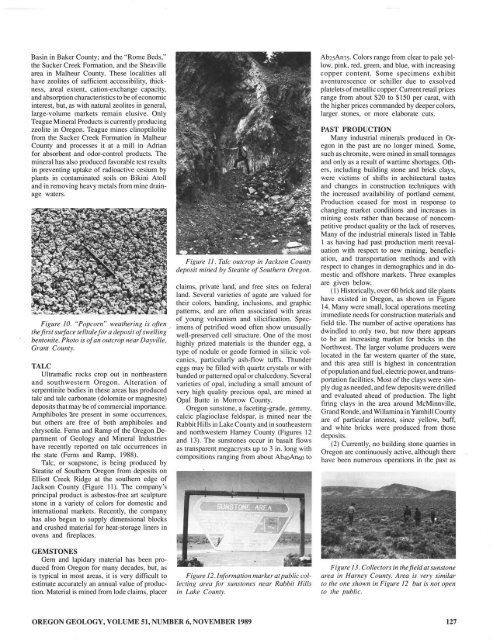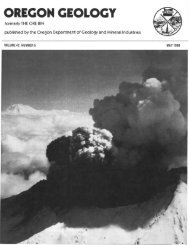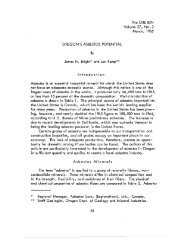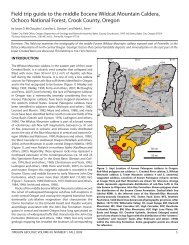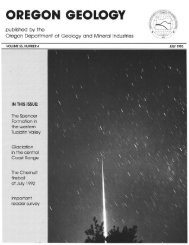Ore Bin / Oregon Geology magazine / journal - Oregon Department ...
Ore Bin / Oregon Geology magazine / journal - Oregon Department ...
Ore Bin / Oregon Geology magazine / journal - Oregon Department ...
Create successful ePaper yourself
Turn your PDF publications into a flip-book with our unique Google optimized e-Paper software.
Basin in Baker County; and the "Rome Beds."<br />
tnc Sucker Creek Fonnation. and the Sheaville<br />
area in Malheur County. These localities all<br />
have zeolites of sufficient accessibility, thickness,<br />
areal extent, cation-exchange capacity,<br />
and absorption characteristics to be of economic<br />
interest, but, as with natural zeolites in general.<br />
large-volume markets remain clusive. Only<br />
Teague Mineral Products is currently producing<br />
zeolite in <strong>Ore</strong>gon. Teague mines clinoptilolite<br />
from the Sucker Creek Fonnation in Malheur<br />
County and processes it at a mill in Adrian<br />
for absorbent and odor-control prooucts. The<br />
mineral has also proouced favorable test results<br />
in preventing uplake o f radioactive cesium by<br />
plants in contaminated soils on Bikini Atoll<br />
and in removing heavy metals from mine drainage<br />
waters.<br />
Figure /0. --Popcorn" weathering is often<br />
thefirst sUrface telltale for a deposit of swelling<br />
bentonite. Photo is of an all/crop near DaYI'ilie.<br />
Grant CO/lillY.<br />
TALC<br />
Ultramafic rocks crop OUi in northeastern<br />
and southwestern <strong>Ore</strong>gon. Alteration of<br />
serpentinite bodies in tncse areas has produced<br />
talc and talc carbonate (dolomite or magnesite)<br />
deposits that may be of commercial importance.<br />
Amphiboles 1lre present in some occurrences.<br />
but others are free of both amphiboles and<br />
chrysotile. Ferns and Ramp of the <strong>Ore</strong>gon <strong>Department</strong><br />
of <strong>Geology</strong> and M'ineral Industries<br />
have recently reported on talc occurrences in<br />
the state (Ferns and Ramp, 1988).<br />
Talc, or soapstone, is being proouced by<br />
Steatite of Southern <strong>Ore</strong>gon from deposits on<br />
Elliott Creek Ridge at the southern edge of<br />
Jackson County (Figure II). The company's<br />
principal product is asbestos-free art sculpture<br />
stone in a variety of colors for domestic and<br />
international markets. Recently, the company<br />
has also begun to supply dimensional blocks<br />
and crushed material for heat-storage liners in<br />
ovens and fireplaces. .<br />
GEMSTONES<br />
Gem and lapidary material has been produced<br />
from <strong>Ore</strong>gon for many decades. but, as<br />
is typical in most areas. it is very difficult to<br />
estimate accurately an annual value of production.<br />
Material is mined from lode claims, placer<br />
Figure II. Talc outcrop in Jackson County<br />
deposit milled by Steatite of Southern <strong>Ore</strong>gon.<br />
claims, private land, and free sites on federal<br />
land. Several varieties of agate are valued for<br />
their colors. banding. inclusions. and graphic<br />
pallems, and are often associated with areas<br />
of young volcanism and silicification. Specimens<br />
of petrified wood often show unusually<br />
well-preserved cell structure. One of the most<br />
highly prized materials is the thunder egg, a<br />
type of nodule or geode formed in silicic volcanics,<br />
particularly ash-flow tuffs. Thunder<br />
eggs may be filled with quanz crystals or with<br />
banded or pallerned opal or chalcedony. Several<br />
varieties of opal. including a small amount of<br />
very high quality precious opal, are mined at<br />
Opal Bulle in Morrow County.<br />
<strong>Ore</strong>gon sunstone. a face ti ng-grade, gemmy,<br />
calcic plagioclase felds par. is mined near the<br />
Rabbit Hills in Lake County and in southeastern<br />
and nonhwestern Hamey County (Figures 12<br />
and 13). The sunstones occur in basalt nows<br />
as transparent megacrysts up to 3 in. long with<br />
compositions ranging from about Ah4oAll6O to<br />
Figure 12.llIformutio/lmark£rol public co/<br />
lecting area for sunstones near Rabbit Hills<br />
in Lake COl/my.<br />
Ab25An75. Colors rapge from clear to pale yellow.<br />
pink. red, green. and blue, with increasing<br />
copper content. Some specimens exhibit<br />
aventurescence or schi ller due to exsolved<br />
platelets of metallic copper. Current retail prices<br />
range from about $20 to $150 per carat, with<br />
the higher prices commanded by deepercolors.<br />
larger stones. or more elaborate cuts.<br />
PAST PRODUCTION<br />
Many industrial minerals produced in <strong>Ore</strong>gon<br />
in the past are no longer mined. Some,<br />
such aschromite, were mined in small tonnages<br />
and only as a result of wanime shonages. Others,<br />
including building stone and brick clays,<br />
were victims of shifts in architectural tastes<br />
and changes in construction techniques with<br />
the increased availability of ponland cement.<br />
Production ceased for most in response to<br />
changing market conditions and increases in<br />
mining costs rather than because of noncompetitive<br />
product quality or tnc lack of reserves.<br />
Many of the industrial minerals listed in Table<br />
I as having had past production merit reevaluation<br />
with respect to new mining. beneficiation,<br />
and transportation methods and with<br />
respect to changes in demographics and in domestic<br />
and offshore markets. Three examples<br />
are given below.<br />
( I) Historically, over 60 brick and tile plants<br />
have existed in <strong>Ore</strong>gon, as shown in Figure<br />
14. Many were small, local operations meeting<br />
immediate needs for construction materials and<br />
field tile. The number of active operations has<br />
dwindled to only two, but now there appears<br />
to be an increasing market for bricks in the<br />
Nonhwest. The larger volume producers were<br />
located in the far western quarter of the state,<br />
and this area still is highest in concentration<br />
of population and fuel,electric power. and trans·<br />
ponation facil ities. Most of the clays were simply<br />
dugas needed, and few deposits were drilled<br />
and evaluated ahead of production. The light<br />
firing clays in the area around McMinnville,<br />
Grand Ronde. and Willamina in Yamhill County<br />
are of panicular interest. since yellow, buff,<br />
and white bricks were produced from those<br />
deposits.<br />
(2) Currently, no building stone quarries in<br />
<strong>Ore</strong>gon are continuously active, although there<br />
have been numerous operations in the past as<br />
Figure 13. Col/ectors in thefield at sunstone<br />
orea in Harney COl/my. Area is I'ery similar<br />
to the one sllown in Figure 12 but is not open<br />
to tile pubUc.<br />
OREGON GEOLOGY, VOLUME 51, NUM8ER 6, NOVEMBER 1989<br />
127


